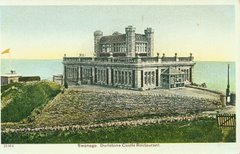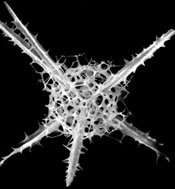
In our first ‘geology excursion’ we went down to Peveril Point. Unfortunately the weather was pretty poor and it was not safe to venture onto the beach itself. However, the point provides superb views back towards Durlston Head and over Swanage Bay to Ballard Down which meant we could talk about the general geology of the area. We could see the Purbeck beds exposed in the cliffs above Durlston Beach and the clear repetition of beds due to a fault near the zig-zag path. The rocks on the west side of the beach are the same sequence as those on the east. At the point itself there is a clear syncline offshore (a fold in the shape of a ‘v’) where we could see each side of the fold dipping inwards. This was Lisa’s chosen point and we could see why she is attracted to it. (In our second trip down to Peveril Point we got to see the syncline spectacularly exposed in the cliffs). In Swanage bay there are Wealden beds which could be seen as reddish sands and are topographically low because they are not very resistant to erosion. In contrast, the chalk of Ballard Down forms a topographic high. There is therefore a clear link between the geology and the surface topography – geomorphology. Richard was particularly interested in the geomorphology of the Isle of Purbeck, particularly how you can trace the line of outcrop of chalk as the downs from the magnificent cliffs east of Swanage, along westwards past Corfe and out to where they outcrop at the coast again at Lulworth.
During the meeting on Thursday 17th, we went back to Peveril Point and this time the gorgeous weather allowed us to gone down onto the beach and hunt for fossils in the Purbeck Beds. It didn’t take much hunting! The rocks are packed with macrofossils – oysters, mussels and snails, plus, with the aid of hand lenses we also found lots of microfossils, specifically ostracods. The ostracods are tiny crustaceans with a bi-valved type shell which preserve as little baked bean-shaped fossils on bedding surfaces. Abigail and Lisa tracked down some circular fish scales and Davina and I found a small fish vertebrae and other fish debris. It also looked like there might be black carbonized wood fragments. I’ve taken some of the rocks that we particularly liked back to the NOC for photography. I look forward to seeing how those turn out. The different associations of rock type and fossils pointed to different environmental conditions, mainly freshwater where we were. We hope to make it further along the beach next time and look for marine fossils and evidence for perhaps hypersaline or brackish conditions. The Purbeck beds were laid down in a variety of shallow water conditions that varied to the degree of marine and freshwater influence.
During the meeting on Thursday 17th, we went back to Peveril Point and this time the gorgeous weather allowed us to gone down onto the beach and hunt for fossils in the Purbeck Beds. It didn’t take much hunting! The rocks are packed with macrofossils – oysters, mussels and snails, plus, with the aid of hand lenses we also found lots of microfossils, specifically ostracods. The ostracods are tiny crustaceans with a bi-valved type shell which preserve as little baked bean-shaped fossils on bedding surfaces. Abigail and Lisa tracked down some circular fish scales and Davina and I found a small fish vertebrae and other fish debris. It also looked like there might be black carbonized wood fragments. I’ve taken some of the rocks that we particularly liked back to the NOC for photography. I look forward to seeing how those turn out. The different associations of rock type and fossils pointed to different environmental conditions, mainly freshwater where we were. We hope to make it further along the beach next time and look for marine fossils and evidence for perhaps hypersaline or brackish conditions. The Purbeck beds were laid down in a variety of shallow water conditions that varied to the degree of marine and freshwater influence.


No comments:
Post a Comment